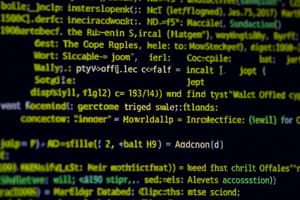Podcast
Questions and Answers
What should the output of the algorithm be after adding three numbers?
What should the output of the algorithm be after adding three numbers?
- The type of the input numbers
- The sum of the three numbers (correct)
- The count of numbers added
- The individual numbers
Which statement correctly describes the process of implementing the algorithm?
Which statement correctly describes the process of implementing the algorithm?
- The sum can only be printed as a floating-point number
- The algorithm should be tested after designing (correct)
- Implementation must start before designing
- Inputs are not necessary for the solution
What is the final step mentioned in the algorithm for adding three numbers?
What is the final step mentioned in the algorithm for adding three numbers?
- Re-enter the numbers if the sum is incorrect
- Calculate the average of the inputs
- Store the input values
- Print the sum of the numbers (correct)
What does the term 'algorithm' refer to?
What does the term 'algorithm' refer to?
Which of the following is a characteristic of a good algorithm?
Which of the following is a characteristic of a good algorithm?
Why is pseudocode useful?
Why is pseudocode useful?
What is the primary purpose of an algorithm?
What is the primary purpose of an algorithm?
What does 'language independent' mean in the context of algorithms?
What does 'language independent' mean in the context of algorithms?
Which of the following is true about the inputs of an algorithm?
Which of the following is true about the inputs of an algorithm?
What term describes an algorithm that does not end in a finite time?
What term describes an algorithm that does not end in a finite time?
What is NOT a benefit of using algorithms?
What is NOT a benefit of using algorithms?
Flashcards
Algorithm
Algorithm
A step-by-step procedure to solve a problem, breaking it down into smaller, manageable parts.
Algorithm Design Steps
Algorithm Design Steps
Steps needed to create an algorithm include identifying the problem, constraints, inputs, outputs, and the solution within those constraints.
Algorithm for adding 3 numbers
Algorithm for adding 3 numbers
A sequence of steps to input three numbers and calculate their sum, declaring variables, and then displaying the result.
Algorithm Input
Algorithm Input
Signup and view all the flashcards
Algorithm Output
Algorithm Output
Signup and view all the flashcards
Variable Declaration
Variable Declaration
Signup and view all the flashcards
Algorithm
Algorithm
Signup and view all the flashcards
Algorithm Basics
Algorithm Basics
Signup and view all the flashcards
Pseudocode
Pseudocode
Signup and view all the flashcards
Characteristics of an Algorithm
Characteristics of an Algorithm
Signup and view all the flashcards
Input
Input
Signup and view all the flashcards
Output
Output
Signup and view all the flashcards
Clear and Unambiguous
Clear and Unambiguous
Signup and view all the flashcards
Well-Defined Inputs
Well-Defined Inputs
Signup and view all the flashcards
Well-Defined Outputs
Well-Defined Outputs
Signup and view all the flashcards
Finite
Finite
Signup and view all the flashcards
Feasible
Feasible
Signup and view all the flashcards
Language Independent
Language Independent
Signup and view all the flashcards
Study Notes
Algorithms
- Algorithms are processes or sets of rules followed in calculations or problem-solving operations
- They are sets of rules/instructions that define how a task is executed step-by-step to achieve the desired outcome
- Algorithms can be understood through examples like following a cooking recipe
- Algorithms help programmers do tasks to get the expected outputs in programming
Pseudocode
- Pseudocode is a simplified way of writing programming code using English phrases
- It's a stepping stone before writing actual code in a specific programming language
- It's helpful for outlining program logic before implementation.
- Pseudocode examples can cover adding numbers and calculating rectangular area.
Characteristics of an Algorithm
-
Clear and Unambiguous: Algorithm steps must be clear and unambiguous, having only one interpretation
-
Well-Defined Inputs: Inputs must be clearly defined if required by the algorithm
-
Well-Defined Outputs: The output expected by the algorithm must be explicitly defined
-
Finite: The algorithm must have a finite number of steps and not result in infinite loops
-
Feasible: The algorithm must be simple, practical and executeable using the available resources.
-
Language Independent: The algorithm's design should be language-independent which means it can be implemented in any programming language.
Advantages of Algorithms
- Algorithms help understand the problem clearly
- They represent a step-by-step solution to a given problem
- Breaking down problems into smaller steps simplifies converting these solutions into actual programs.
How to Design an Algorithm
- Understand the problem to be solved.
- Identify constraints on solving the problem.
- Define the input needed for problem solving
- Decide on the expected output for the problem solution in reference to the given constraints
- Describe a solution to the problem in consideration to these constraints.
Example: Add 3 Numbers
- Problem: Adding three numbers and displaying their sum
- Constraints: Input numbers are digits only.
- Input: Three numbers (e.g., num1, num2, num3)
- Output: Sum of the three input numbers
- Solution: Add the three numbers using the addition operator or a similar method.
Designing the Algorithm to add 3 numbers
- Declare variables to store three numbers, (num1, num2, num3).
- Declare one more variable sum.
- Take input of the three numbers one by one and store in declared variables.
- Add the three numbers and store the result in the 'sum' variable.
- Print the value of 'sum' variable..
Studying That Suits You
Use AI to generate personalized quizzes and flashcards to suit your learning preferences.




